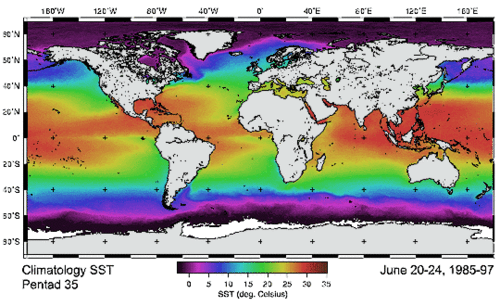Sensors: AVHRR
From

The Advanced Very High Resolution Radiometer (AVHRR) is a space-borne sensor embarked on the National Oceanic and Atmospheric Administration (NOAA) family of polar orbiting platforms (POES). AVHRR instruments measure the reflectance of the Earth in 5 relatively wide (by today's standards) spectral bands. The first two are centered around the red (0.6 micrometres, 500 THz) and near-infrared (0.9 micrometres, 300 THz) regions, the third one is located around 3.5 micrometres, and the last two sample the thermal radiation emitted by the planet, around 11 and 12 micrometres, respectively. The NOAA satellite has equator crossing times of 0730 and 1930 local solar time.[1]
The first AVHRR instrument was a 4-channel radiometer, while the latest version (known as AVHRR/3, first carried on the NOAA-15 platform launched in May 1998) acquires data in a 6th channel located at 1.6 micrometres.
Contents |
Operational procedures
NOAA has at least two polar-orbiting meteorological satellites in orbit at all times, with one satellite crossing the equator in the early morning and early evening and the other crossing the equator in the afternoon and late evening. The primary sensor on board both satellites is the AVHRR instrument. Morning-satellite data are most commonly used for land studies, while data from both satellites are used for atmosphere and ocean studies. Together they provide twice-daily global coverage, and ensure that data for any region of the earth are no more than six hours old. The swath width, the width of the area on the Earth's surface that the satellite can "see", is approximately 2,500 kilometers (about 1,500 miles). The satellites orbit between 833 or 870 kilometers (+/- 19 kilometers, between 516 and 541 miles) above the surface of the Earth.[2]
The highest ground resolution that can be obtained from the current AVHRR instruments is Template:Convert, which means that the satellite records discrete information for areas on the ground that are 1.1 by 1.1 kilometers. This smallest recorded unit is called a pixel. AVHRR data have been collected continuously since 1981.[2]
Applications
The primary purpose of these instruments is to monitor clouds and to measure the thermal emission (cooling) of the Earth. These sensors have proven useful for a number of other applications, however, including the surveillance of land surfaces, ocean state, aerosols, etc. AVHRR data are particularly relevant to study climate change and environmental degradation because of the comparatively long records of data already accumulated (over 20 years). The main difficulty associated with these investigations is to properly deal with the many limitations of these instruments, especially in the early period (sensor calibration, orbital drift, limited spectral and directional sampling, etc.).
The AVHRR instrument also flies on the MetOp series of satellites. The three planned MetOp satellites are part of the Eumetsat Polar System (EPS) run by Eumetsat.
Calibration and validation
Remote sensing applications of the AVHRR sensor are based on validation (matchup) techniques of co-located ground observations and satellite observations. Alternatively, radiative transfer calculations are performed. There are specialized codes which allow simulation of the AVHRR observable brightness temperatures and radiances in near infrared and infrared channels.[3][4]
Next-generation system
Operational experience with the Moderate Resolution Imaging Spectroradiometer MODIS[5] sensor onboard NASA's Terra and Aqua led to the development of AVHRR's follow-on, VIIRS.[6] VIIRS is currently operating onboard the NPOESS Preparatory Project satellite and will be deployed onboard the Joint Polar Satellite System in the late 2016 timeframe.[7]
Launch and service dates
| Satellite name | Launch date | Service start | Service end |
|---|---|---|---|
| TIROS-N | 13 Oct 1978 | 19 Oct 1978 | 30 Jan 1980 |
| NOAA-6 | 27 Jun 1979 | 27 Jun 1979 | 16 Nov 1986 |
| NOAA-7 | 23 Jun 1981 | 24 Aug 1981 | 7 Jun 1986 |
| NOAA-8 | 28 Mar 1983 | 3 May 1983 | 31 Oct 1985 |
| NOAA-9 | 12 Dec 1984 | 25 Feb 1985 | 11 May 1994 |
| NOAA-10 | 17 Sep 1986 | 17 Nov 1986 | 17 Sep 1991 |
| NOAA-11 | 24 Sep 1988 | 8 Nov 1988 | 13 Sep 1994 |
| NOAA-12 | 13 May 1991 | 14 May 1991 | 15 Dec 1994 |
| NOAA-14 | 30 Dec 1994 | 30 Dec 1994 | 23 May 2007 |
| NOAA-15 | 13 May 1998 | 13 May 1998 | Present |
| NOAA-16 | 21 Sep 2000 | 21 Sep 2000 | Present |
| NOAA-17 | 24 Jun 2002 | 24 Jun 2002 | Present |
| NOAA-18 | 20 May 2005 | 30 Aug 2005 | Present |
| NOAA-19 | 6 Feb 2009 | 2 Jun 2009 | Present |
| MetOp-A[8] | 19 Oct 2006 | 20 Jun 2007 | Present |
| TIROS/NOAA dates from USGS website[9] and from NOAA POES Status website[10] | |||
References
External links
- What is AVHRR? at National Atlas
- Advanced Very High Resolution Radiometer at NOAA
- Advanced Very High Resolution Radiometer at USGS
- [1] at NASA
- [2] at NASA
Literature
fr:Radiomètre Avancé à Très Haute Résolution pl:Advanced Very High Resolution Radiometer
